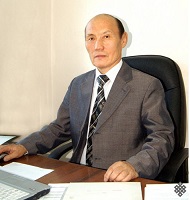Traditions of the Tuvan artisan Saayalar kinship group
DOI:
https://doi.org/10.25178/nit.2022.1.13Keywords:
Tuvans; Tuva; genealogy; kinship group; Saaya; Kogel Mizhiteyevich SaayaAbstract
This article is a study of a composition of a separate kinship group of Tuvans following traditional pursuits and skills — shever Saayalar aal-aimaa (the family of the skilful (artisans) Saaya). The author belongs to the group as well. For our sources, we have used personal observations, field materials, memories and talks of the older generation.
The Shever Saayalar stand closer to the Aksy-Barlyk Saayalar of the Barun-Khemchig rayon. Besides Aksy-Barlyk, they have lived in such settlements as Azhyg-Kara-Sug, Chaylag-Oyum, Ak-Sug, Kyshtag-Oyum, Kөzheelig, and Kөөp-Sөөk of the Bay-Taygin rayon. Recently, some of the families moved to Kyzyl-Mazhalyk (Barun-Khemchig rayon), or to such towns and cities as Ak-Dovurak and Kyzyl, and to other rayons of the republic. Some members of the aimag live in other regions of Russia. The oldest and most widely known representative of the Shever Saayalar was Kogel Mizhiteyevich Saaya (1931–2021), member of the Union of Artists of the USSR.
We provide information on the kinship group up to the seventh-generation ancestor Saaya Kara-Dargan (c. 1805–1855), as well as explain why the group is called Shever. Of special interest for us is the life of Dargan-Khelin (c. 1830–1905), a skilled blacksmith (dargan), who was a student in Tibet for many years and was awarded the Buddist degree of kheliң. Upon returning to his homeland, Dargan-Khelin made religious figurines, decoration for Buddhist temples, and jewellery, in addition to holding divine services. He passed on his skills to his children and grandchildren.
Artisanship and common pursuits in life linked generations together, made kinfolk feel close to each other and stimulated them to strive for new forms of knowledge. The backbone of the group was preserved, and its members are taking on the artisanship and art they inherited from their ancestors to a new level.
References
Lamazhaa, Ch. K. (2021) Osnovnye problemy issledovaniia rodstva i rodstvennykh grupp sovremennykh tuvintsev: paspor¬tizatsiia, terminologiia i podderzhanie rodstva [The main issues of the study of kinship and kin groups of xontemporary Tuvans: passportization, terminology and maintenance of kinship]. New Research of Tuva, no. 4, pp. 6-21. (In Russ.). DOI: https://www.doi.org/10.25178/nit.2021.4.1
Oorzhak, V. O. (2018) Dobycha chonar-dasha: traditsionnaia tekhnologiia i element ekologicheskoi kul'tury tuvintsev [The extraction of the Chonar-Dash: traditional technology and a part of Tuvan environmental culture]. New Research of Tuva, no. 4, pp. 210–234. (In Russ.). DOI: https://doi.org/10.25178/nit.2018.4.12
Oorzhak, V. O. (2020) Tuvinskie traditsionnye metody tochnykh raschetov pri izgotovlenii karkasa iurt [Tuvan traditional methods of precise computation in the making of the yurt frame]. New Research of Tuva, no. 4, pp. 64–79. (In Russ.). DOI: www.doi.org/10.25178/nit.2020.4.5
Tuvinsko-russkii slovar' [A Tuvan-Russian Dictionary] (1968): c. 22000 words / ed. by E. R. Tenishev. Moscow, Sovetskaia entsiklopediia. 465 p. (In Russ. and Tuv.).
Published
How to Cite
For citation:
Oorzhak V. O. Traditsii tuvinskogo roda remeslennykh (iskusnykh) Saaialar [Traditions of the Tuvan artisan Saayalar kinship group]. New Research of Tuva, 2022, no. 1, pp. 198-210. (In Russ.). DOI: https://www.doi.org/10.25178/nit.2022.1.13
Issue
Section

This work is licensed under a Creative Commons Attribution-NonCommercial 4.0 International License.

Author(s) license holder(s) grant rights for their work to the journal (grantee of a license) under the simple non-exclusive open license in accordance with Art. 1286.1 «Open license for a research work, work of literature or fine arts», Civil Code of the Russian Federation.
New Research of Tuva publishes articles under the Creative Commons Attribution-NonCommercial license (CC BY-NC).
Since it is an open license, author(s) reserve the right to upload the article to their institutional repository, submit it to another journal (if it allows republications), or republish it on their own website (in full, or in part).
However, several conditions apply here:
a) The republished version must always contain the name(s) and affiliation(s) of the author(s), the original title and the hyperlink to the original version on the New Research of Tuva website;
b) It must be in open access, free of charge, and no category of readers must be in any way whatsoever advantaged over general readership.
c) should the contribution be submitted elsewhere by its author(s) without substantial modification (30% or more of original text unchanged), the body of the article should contain a disclaimer that the original version was published in New Research of Tuva (with a link to the respective page)
The CC-BY-NC is a non-revocable license which applies worldwide and lasts for the duration of the work’s copyright.









